This article needs additional citations for verification .(June 2023) |

The Smbat walls were medieval fortifications built during the 10th century in the Kingdom of Armenia.
This article needs additional citations for verification .(June 2023) |

The Smbat walls were medieval fortifications built during the 10th century in the Kingdom of Armenia.
The walls were made from smoothly hewn yellow stones, decorated in places with red and black stones, which formed patterns of crosses, swastikas and chessboard motifs. The towers and walls of the fortress were decorated with many bas-reliefs of a dragon, seizing the heads of a bull or an eagle or holding a lamb in its talons and a tiger in movement. The architectural design of the “Kars” and “Dvin” gates give the “Smbat” walls a monumental aspect. These massive gates, found by archaeologists during excavations[ when? ], were covered in thick iron plates and were held shut by beams, encircled with hoops at the end.
Having completed his construction work on the fortress, king of Armenia Smbat went on to build a number of beautiful buildings and a marvellous palace complex on the acropolis. The palace, which stood on the top of a hill, was surrounded by a separate system of fortress walls and was the principal residence of the Bagratids. The king's official rooms and the residential part of the palace were divided off from one another by a wide corridor and the whole palace took up one sixth of the acropolis (4,900 square metres) and consisted of many rooms. In the North-Western corner of the palace there was a reception room (21 metres x 10.5 metres), which was faced with smoothly hewn stone and decorated with a multi-faceted carved colonnade. In the next room, figures of animals, framed with plants were moulded in plaster. In a third room, which was built in the form of a basilica, the walls were decorated with military scenes and covered in gold leaf; the arched wooden ceiling was decorated with carvings.

A palace is a grand residence, especially a royal residence, or the home of a head of state or some other high-ranking dignitary, such as a bishop or archbishop. The word is derived from the Latin name palātium, for Palatine Hill in Rome which housed the Imperial residences.

Abas was king of Bagratid Armenia from 928 to 953. He was a member of the Bagratid (Bagratuni) royal dynasty. He was the son of Smbat I and the brother of Ashot II the Iron, whom he succeeded. In contrast to the reign of his predecessors, Abas's reign was mostly peaceful, and he occupied himself with the reconstruction of the war-torn kingdom and the development of his capital at Kars.

Buda Castle is the historical castle and palace complex of the Hungarian Kings in Budapest. It was first completed in 1265, although the massive Baroque palace today occupying most of the site was built between 1749 and 1769. The complex in the past was referred to as either the Royal Palace or the Royal Castle. The castle now houses the Hungarian National Gallery and the Budapest Historical Museum.
Gagik II was the last Armenian king of the Bagratuni dynasty. Known as Gagik II King of Ani he was enthroned as Gagik II and ruled for a brief period from 1042 to 1045 before the Bagratid dynasty rule collapsed in Armenia.
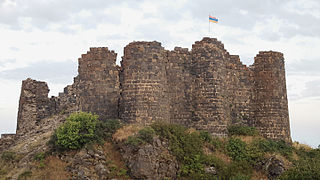
Amberd is a 10th-century fortress located 2,300 meters (7,500 ft) above sea level, on the slopes of Mount Aragats at the confluence of the Arkashen and Amberd rivers in the province of Aragatsotn, Armenia. The name translates to "fortress in the clouds" in Armenian. It is also the name incorrectly attributed to Vahramashen Church, the 11th-century Armenian church near the castle. The village of Byurakan is 6.4 kilometres (4.0 mi) from the site of Amberd.

Gagik I was the king of Armenia who reigned between 989 and 1020, under whom Bagratid Armenia reached its height, and "enjoyed the accustomed experience of unbroken peace and prosperity."
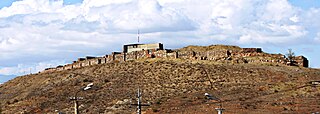
Erebuni Fortress is an Urartian fortified city, located in Yerevan, Armenia. It is 1,017 metres (3,337 ft) above sea level. It was one of several fortresses built along the northern Urartian border and was one of the most important political, economic and cultural centers of the vast kingdom. The name Yerevan itself is derived from Erebuni.

The Kingdom of Tashir-Dzoraget, alternatively known as the Kingdom of Lori or Kiurikian Kingdom by later historians, was a medieval Armenian kingdom formed in the year 979 by the Kiurikian dynasty, a branch of the Bagratuni dynasty, as a vassal kingdom of the Bagratid Kingdom of Armenia. The first capital of the kingdom was Matsnaberd, currently part of modern-day Azerbaijan.
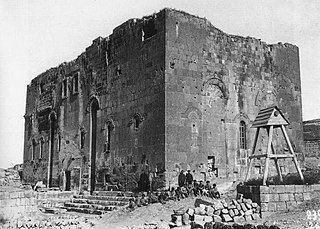
Shirakavan ; founded as Yerazgavors and later Yerazgavork, was a medieval Armenian city and one of the 13 historic capitals of Armenia, serving as a capital city between 890 and 929 during the Bagratid Kingdom of Armenia.

Smbat II reigned as King of Armenia from 977 to 989. He was of the Bagratuni line of kings, and the son of Ashot III, whom he succeeded.

The Cathedral of Ani is the largest standing building in Ani, the capital city of medieval Bagratid Armenia, located in present-day eastern Turkey, on the border with modern Armenia. Its construction was completed in the early 11th century by the architect Trdat and it was the seat of the Catholicos, the head of the Armenian Apostolic Church, for nearly half a century.

Haghpat Monastery, also known as Haghpatavank, is a medieval monastery complex in Haghpat, Armenia, built between the 10th and 13th century.

Ani is a ruined medieval Armenian city now situated in Turkey's province of Kars, next to the closed border with Armenia.
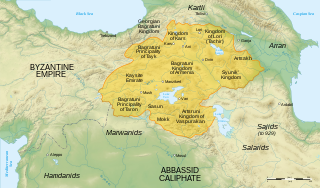
Bagratid Armenia was an independent Armenian state established by Ashot I Bagratuni of the Bagratuni dynasty in the early 880s following nearly two centuries of foreign domination of Greater Armenia under Arab Umayyad and Abbasid rule. With each of the two contemporary powers in the region—the Abbasids and Byzantines—too preoccupied to concentrate their forces in subjugating the region, and with the dissipation of several of the Armenian nakharar noble families, Ashot succeeded in asserting himself as the leading figure of a movement to dislodge the Arabs from Armenia.

Ashot III was a king of Armenia, ruling the medieval kingdom of Armenia from 952/53–77. Known as Ashot III the Merciful and acknowledged by foreign rulers as the Shahanshah of Mets Hayk', he moved his royal seat of residence to Ani and oversaw its development and of the kingdom as a whole. Armenia reached the height of its golden era during his reign and that of his sons and successors, Smbat II (977–89) and Gagik I (990–1020).

The Cathedral of Kars, also known as the Holy Apostles Church is a former Armenian Apostolic church in Kars, eastern Turkey. Built in the mid-10th century by the Armenian Bagratid King Abas I, it was converted into a mosque in 1579. In the 19th and early 20th century it was converted into a Russian Orthodox and later Armenian cathedral. In 1993 it was again converted into a mosque and is called Kümbet Mosque. It currently comprises part of a larger Islamic complex that includes the Evliya Mosque, the biggest mosque in Kars.
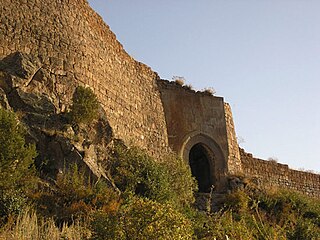
Smbataberd is a medieval fortress located upon the crest of a hill between the villages of Artabuynk and Yeghegis in the Vayots Dzor Province of Armenia. It may have existed as early as the fifth century or earlier, although other sources date it to the ninth to eleventh centuries. Its large basalt walls have been well preserved, but much less remains of the structures inside the fortress. It served as the main fortress of the Armenian princes of Syunik when Yeghegis was the seat of the rulers of that province. It was further expanded in the thirteenth century under the Orbelian dynasty. It is now a notable tourist site in Vayots Dzor.

Yerazgavorsi Surb Amenaprkitchi Vank is an Armenian monastery in the village of Çetindurak in the Kars Province of present-day Turkey. This corresponds to the Shirakavan settlement of Historical Armenia, also known by its older name of Yerazgavors, developed into a small town in the mid-ninth century AD. It was located about 25 km Northeast of Ani, the capital of the medieval Bagratid (Bagratuni) Armenian Kingdom.

The Bagratuni or Bagratid dynasty was an Armenian royal dynasty which ruled the medieval Kingdom of Armenia from c. 885 until 1045. Originating as vassals of the Kingdom of Armenia of antiquity, they rose to become the most prominent Armenian noble family during the period of Arab rule in Armenia, eventually establishing their own independent kingdom. Their domain included regions of Armenia such as Shirak, Bagrevand, Kogovit, Syunik, Lori, Vaspurakan, Vanand and Taron. Many historians, such as Cyril Toumanoff, Nicholas Adontz and Ronald Suny, consider them to be the progenitors of the Georgian royal Bagrationi dynasty.
The Bagratuni family tree describes the heritage of the Bagratuni family in Armenia and Georgia.